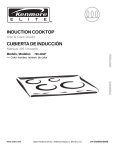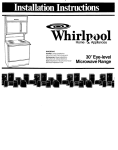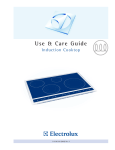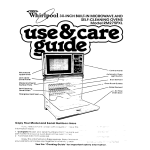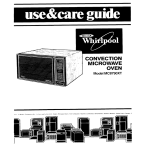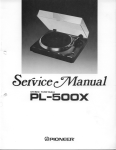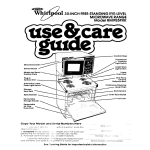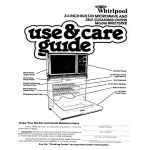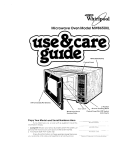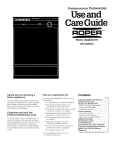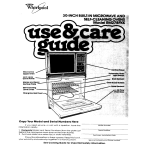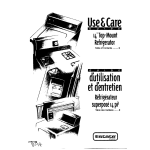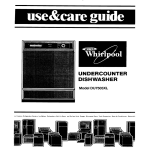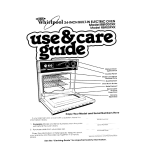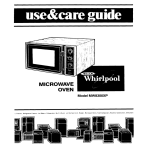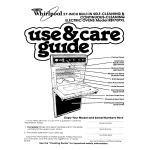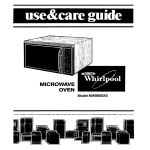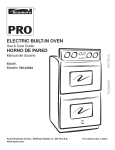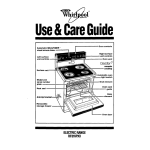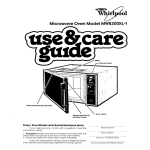Download Whirlpool RM235PXK User's Manual
Transcript
rc Whirlpool 304NCH BUILT-IN MICROWAVE AND CONTINUOUS-CLEANING OVENS Model RM235PXK Control Panel ode1 and Serial Number Plate inuous-Cleaning Lower Oven Broil Element Silicone Oven Heat Seal Rack Guides Removable Copy Your Model and Serial Numbers If vou neell service or call with a information reoc-$ 1 Complete Model and Serial Ntimbers behtnd the microwave oven door on the 2 Purc:,ase date +rom sales slip [or date question. Here have this (from the plate oven frame] installed) just ~ ~~- ~--~~ ~~~ ~~~~~ Model Guide”tor important Serwce satety Number Serral Number Purchase C:;yy this iritormatlon In these spaces. Keep this book, your warranty arld sales slop together in a handy place. See the “Cooking Air-Flow Company information. lnstallatlon Dote and Phone Number Your responsibilities. l l Proper installation and safe use of the ovens are your personal responsibilities. Read this “Use and Care Guide”and the “Cooking Guide”carefully for important use and safety information. Installation l l You must be sure your oven Is... l properly connected to the corinstalled and leveled in a wall rect electric supply and that will hold the weight: grounding. (See “Installation installed in a well-ventilated Instructions.“) area protected from the weather; Proper use I You must be sure your oven is... l used only for jobs expected of home ovens; used only by people operate it properly; 0 properly maintained. l Contents Your Responsibilities Ir~stallatrori Proper IJsn Safety Precautrcns to Avoid Possrbie txposure to Excessrve Microwave Energy Usrng the Microwave UpperOven Setting the Controls Defrosting The Meal Sensor Temperature Probe Bi-Level Oven Rack Cleaning the Microwave Oven Important Information how MicrowaveOvens Work Using Your Lower Oven Setting the Clock Using the MinuteTimer The Lower Oven Controls Baking or Roasting Adjusting the Oven Temperature Control Using the Automatic MEALTIMER Clock Broiling Broiling Chart The Oven Lights The Oven Vents Cleaning and Caring for Your Oven Control Panel and Knobs -The Continuous-Cleaning Lower Oven Removing the Lower Oven Door Cleaning Chart The Optional Rotisserie If You Need Service or Help I, Before You Call for Service 2. If You Need Service 3. If You Have a Problem who can Page 2 2 2 3 4 4 5 5 6 7 8 8 10 10 11 11 11 12 12 13 14 14 15 15 15 15 16 17 18 18 19 19 19 20 >Tmk 3 Using your microwave upper oven Microwave Probe Signal Oven Controls Light Meal Sensor Probe Control Digital Cook Timer Power Control Start Button Tmk SETTING THE CONTROLS Be sure You understand the basics of microwave oven cooking before You start. Start with recipes from Your MICRO MENUS- Cookbook. Follow the directions carefully. NEVER START THE OVEN WHEN IT’S EMPTY. The oven can be damaged. For testing, use at least a cup of water Be sure you have read and understand the dlrectlons. 1. 2. Put food in the oven Close the door. Make sure it locks. The oven won’t work if the door isn’t closed tightly. 3. Set cooking times up to 10 minutes by pushing in the timer knob and turning clockwise. The oven light will goon. Push in and turn counterclockwise to reduce time. i ‘1; I i I ’ 4. Set cooking times longer than 10 minutes by turning the timer knob and wheel. First set the knob, then move the wheel. Example: to set 22 minutes, 30 seconds.,. 0 Set 2 minutes, 30 seconds by pushing in and turning knob. l Set 20 minutes by pushing up on wheel. DEFROSTING For defrosting, set Cook Power Control to DEFROST (MED-LO) setting. See the Defrost Guide inside the oven door or Your MICRO MENUS. Cookbook for suggested defrost times, -Tmk 5. Set Cook Power to desired setting from HI to LO. Some recipes require different Cook Powers for best results, (See chart] -COOK POWER CHARTRecipes in the MICRO MENUS- Cookbook use Cook Power settings from HI to LO. Recipes in other books and magazines may use different percentages of cooking power. The following chart will be helpful: HI - 100% of full power MED-HI - 70% of full power MED - 50%of full power MED-LO - 30% of full power (DEFROST) LO - 15% of full power 6. Push the START Button. The oven light will stay on. You will hear a fan running during oven operation. When the set time is up, the oven will shut off automatically. You will hear a bell, the light will go off and the fan will stop. TO STOP THE OVEN 1. Push in and turn the timer knob counterclockwise to 0o:oo. OR 2. Open the oven door. TO RESTART THE OVEN 1. 2. 3. Close the oven door. Set timer [if needed). Push the START Button 5 THE MEAL SENSOR+ TEMPERATURE PROBE Roast or bake meats or casseroles to a set temperature instead of by time. When the Meal Sensor. Temperature Probe is properly used, the microwave oven will turn off automatically when the probe senses the temperature you set. For liquids, balance the probe on a wooden spoon or spatula so the tip of the probe is in the center of the liquid. For casseroles, the tip of the probe should be in the center of the food. Stir foods when recommended. Replace the probe. ///->& For roasts, the tip of the probe should be in the center of the largest muscle, but not touchtng fat or bone. Plug ,I Cable ‘, \ Sensor _ _ ‘kq-$ I z Socket -c 1. insert at least ‘1 of the temperature probe into the food. 2. Place food in the oven and plug the probe into the socket on the oven wall. The Probe Signal Light will come on. 3. Make sure the probe does not touch any part of the oven Interlor. Close the door. 4. Set the Cook Power if desired. 5. Move the Meal Sensor pointer to the final cooking temperature you want. 6. Push the START Button. When the probe senses the cooking temperature, a buzzer sounds, and the oven turns off DO... l l l l l 6 use hot pads when removing probe from food or food from oven. unplug probe from socket to turn off oven light. stir foods during cooking when recommended. stir soups, casseroles and drinks before serving. cover roasts with foil and let stand a few minutes after cooking. Remove foil if you decide to cook it longer. DON’T... let probe or probe cable touch any part of the oven interior. l let probe touch foil [if used). Foil can be kept away from probe with wooden toothpicks Remove foil if arcing occurs. 0 use paper, plastic wrap or plastic containers. They will be in the oven too long. l use probe in regular oven. l force probe into frozen food. l use probe for foods that need to simmer. l *Tmk MEAL SENSOR” TEMPERATURE PROBE GUIDE Cook Power Setting HIGH Meal Sensor Setting 165 Fto 170 F Tips HIGH 170 F Use MEDIUM Cook Power for very thick foods such as baked beans. Casseroles MEDIUM HIGH 170 Fto 175 F Use MEDIUM Cook Power for very thick mixtures. Stir once or twice. Chowders MEDIUM HIGH 180 F Balance probe once or twice. MEDIUM 140 F Food Beverages Canned Food Dips Meat Loaf (beef) Poultry Balance probe on wooden on wooden spoon. spoon. Stir MEDIUM HIGH 170 F Do not use the Meal Sensor probe when cooking poultry. Because of the amount of bone and shape of poultry, there is no place .+/here the meat is thick enough to place the probe properly. Sandwiches MEDIUM 110 F Place sandwich on paper napkin. Insert probe from side so tip is in center of filling. Thick sandwiches work best. soup HIGH 165 Fto 170 F Balance probe once or twice. on wooden spoon. Stir TIPS l l l l Casseroles cooked using the MEAL SENSOR probe should be made from precooked foods. Do not use raw meats, raw vegetables and cream sauces in casseroles. Dry casseroles in several of the items -all not heat at the same rate. . Dry meat loaf mixtures do not work well. l Thaw frozen casseroles and meats in the microwave oven before inserting the probe. If you are cooking individual servings such as mugs of soup, check the probe setting CLEANING l the mugs may don’t work well Remember that roasts may vary in size, shape and composition Use the timings for minutes per pound as a guideline as well as the MEAL SENSOR probe. Starchy vegetables SENSOR probe. tend to stick to the MEAL THE PROBE: 1. Remove probe from mlcrowave oven using hot pads 2. Wipe probe with a hot sudsy cloth. Use a plastic scouring pad to remove stubborn foods. Do not immerse probe in water or wash in the dishwasher. Be careful not to kink the cable. BI-LEVEL OVEN RACK Use the Bi-Level Oven Rack to stack foods when cooking in more than one container. The rack can be turned upside-down to help fit taller containers on the bottom of the oven First Position: Use the rack only when heating more than one container of food. Do not let a container touch the top of the oven. SPECIAL CAUTIONS l l Second Position: Turn rack upside-down when using a taller container on the bottom of the oven. l l CLEANING THE RACK l l l l Wash by hand with a mild detergent. Wash on the top rack of a dishwasher. Do not use abrasive scrubbers or cleansers. Do not use with browning dish. Use only when cooking foods in more than one container. Do not use in conventional ovens or under broiler. Do not let food or container touch the top of the oven. Do not store rack in the oven Tmk 7 For stubborn soil, boil a cup of water in the oven for 2 or 3 minutes. Steam will soften the soil. Wipe often with warm sudsy water and a soft cloth or sponge. Do not use abraslve IMPORTANT cleaners before oven, read this section your carefully, This oven. Trim Cooking in metal containers can damage the oven. So can containers with hldden metal [twist-ties, foil-lining, staples, metallic glaze or or cooktrim]. Test dinnerware wore or steel wool pads. INFORMKTION Before you start using your microwave information will help you avoid damage to Metallic Be sure to clean the areas where the door and oven frame touch when closed. Rinse well. using. Paper can char or burn, and some plastics can melt if used when heating foods for more than 4 minutes. To test o dish for safe use, put it into the oven with a cup of water beslde it. Cook on high Cook Power for one minute. If the dlsh gets hot and the water stays cool, do not use It. NEVER COOK OR REHEAT A WHOLE EGG. Slice hard boiled eggs before heating. Steam build-up in whole eggs may cause them to burst and possibly damage the oven. NEVER start a microwave oven when it’s empty. The oven can be damaged. If you experiment, put a container of water in the oven. Don’t let anything touch the top of the oven cavity. Contrtued next page Rough or harsh cleaners DO NOT store things in the can scratch or dull the oven. oven finish. DO NOT USE THEM. Overcooking some foods can cause them to scorch or flame...especially foods like potatoes, popcorn, snacks, etc. See the MICRO MENUSCookbook. ,Tmk Make popcorn only in poppers designed for use in microwave ovens. Follow popper directions. Results are the popper manufacturer’s responsibility. Liquids heated in certain containers may overheat. The liquid may then splash out with a loud noise. This does not harm the oven, but you should not use such containers to heat liquids again. DO NOT OVERCOOK POTATOES. At the end of the recommended cooking time they should be slightly firm. Wrap in foil and set aside for 5 minutes. They will finish cooking while standing. USE HOT PADS. Microwave energy does not heat containers, but the hot food does. Follow MICRO MENUS Cookbook directions carefully. If using a different cookbook, you may need to experiment with times and Cook Powers. It is normal for the inside of the oven door to look wavy after the oven has been running for a while. VWl!A l l v If your electric power line voltage is less than the normal 240 volts, cooking times may be longer. Double-check all settings. Use the oven only for defrosting, cooking or reheating. It is normal for the signal lights to flicker while the microwave oven is on. 9 Microwave ovens are safe. Microwave energy is not hot. It causes make its own heat, and it’s this heat that cooks the food. Stirrer \ food to Magnetron I Glass Shelf c Oven iavity Microwaves are like TV waves or light waves. You can’t see them, but you can see what they do. A magnetron produces microwaves The microwaves move into the oven where they are scattered around by a stirrer (like a fan). Microwaves bounce off metal oven walls and are absorbed by food. Microwaves pass through glass, paper and plastic without heating them so food absorbs the energy. Microwaves bounce off metal pans so food does not absorb the energy. Microwaves may not reach the center of a roast. The heat around the outside is what cooks the roast all the way through. This is one of the reasons for letting some foods (roasts, baked potatoes] stand for a while after cooking, or for stirring some foods during the cooking time usingyour Metdl Bottom The glass bottom of your microwave oven lets microwaves through. Then they bounce off a metal floor, back through the glass bottom and are absorbed by the food. The microwaves disturb water molecules in the food. As the molecules bounce around bumping into each other, heat is made, like rubbing your hands together. This is the heat that cooks. lower oven lower Oven Controls Stop Time Knob Start Time Knob Automatic Minute MEALTIMER” Clock Timer Oven Selector Adjustable Oven Temperature Oven Signal Manual Oven Control light Light Switch *lmk SETTING THE CLOCK 1. Push In Mlnute Tlmer Knob and turn clockwlse until clock digits show the right time of day. 2. let the Minute T’lmer Knob pop out. Turn counterclockwise until the Minute Timer dial is on OFF. If you push in on the knob, you will change USING THE MINUTE 1. the time of day TIMER Wlthout pushlng It In, turn the Minute Timer Knob until the setting showing in the window is longer than the one you want. 2. Turn the knob back so the setting want shows in the window. you 3. When the set time is up, a buzzer sound. will 4. Turn the dial to OFF to stop the buzzing THE LOWER OVEN CONTROLS The lower oven is controlled by two knobs: the Oven Selector and the Oven Temperature Control. Both must be on o setting for the oven to heof. THE OVEN SELECTOR BROIL, only the top element heats. (Broiling, pg, 14). BAKE, the bottom element does most of the work. The top element heats, but does not turn red. (Baking, pg. 12). THE OVEN TEMPERATURE CONTROL Use the Oven Temperature Control to set baking or roasting temperature when the Oven Selector is on BAKE or TIMED. When both the Oven Selector and Temperature Control are on BROIL, the broil element heats all the time. The With the Oven Selector TIMED, the MEALTIMERcan be used to turn the on and off automatically. (MEALTIMER Clock, pg. on Clock oven 13). .Tmk Oven Temperature Control can be set on a temperature for slower broiling [see Broiling, page 14). 11 Put the rack(s) where you want them before turning on the oven. Rack(s) should be placed so food can be centered in the oven. Always leave at least 1% to 2 inches (4-5 Cm] between the sides of the pan and the oven walls and pans. For more information, see the “Cooking Guide.” Lift rack at front and pull out Set the Oven Selector BAKE. on walls and ADJUSTING door 4 Set the Oven Temperature Control to the baking temperature you want. 6 Let the oven preheat until the Signal Light goes off. 7 During baking, the elements will turn on and off to help keep the oven temperature at the setting. The Signal Light will turn on and off with the elements. The top element helps heat during baking, but does not turn red. Put food in the oven. Oven rock, 3 When baking is done, turn both knobs to OFF. will be hot THE OVEN TEMPERATURE CONTROL Does your new oven seem to be hotter or colder at the same old oven? The temperature setting in your old oven may have ally overthe years. The accurate setting of your new oven can If you think the oven temperature needs adjusting, follow these OFF OFF Locking 1. Pullmout the center of the Oven Temperature Control. 12 2. Screw Loosen the locking screw. lighten the locking Tooth settings than your changed graduseem different. steps: OFF Notches 3. To lower the tem- screw. perature, move black ring so tooth is closer to LO. Each notch equals about 10 F (5 C]. Replace the knob. Tooth 4. Notches To raise the temperature, move black ring so tooth is closer to HI. Each notch equals about 10 F (5 C). USING THE AUTOMATIC MEALTIMER” CLOCK The Automatic MEALTIMER’ Clock is designed to turn the lower at times you set...even when you are not around. To start and stop baklng 1. automatically: Put the lower oven rack(s) where you want them and place the food in the oven. 2. Push in and turn the Stop rime Knob clockwise to the time you want the oven to shut off. 5. 7. After baking is done, turn both knobs to OFF. 8. 1. 2. 3. Make sure the clock is set to the right time of day. to the time you want baking to start. 4. To stop baking oven on and off Set the Oven Selector TIMED. on 6. Set the Oven Temperature Control on the baking temperature you want, To stop the oven before the preset time, turn both knobs to OFF. automatically: Put the oven rack(s) where you want them and place the food in the oven. Make sure the clock is set to the right time of day. Push in and turn the Stop Time Knob clockwlse to the time you want the oven to shut off. 4. Set the Oven Selector on TIMED. 5. Set the Oven Temperature Control on the baking temperature you want. 6. After baking is done, turn both knobs to OFF. 7. To stop the oven before the preset time, turn both knobs to OFF. SPECIAL CAUTION: Use foods that will not go bad or spoil while waiting for cooking to start. Avoid using dishes with milk or eggs, cream soups, cooked meats or fish, or any item with baking powder or yeast. Smoked or frozen meats may be used; so can vegetables, fruits and casseroletype foods. Vegetables can be cooked in *Tmk a covered baking dish with about a halfcup (118 mL) of water for 1 to 1% hours. Any food that has to wait for cooking to start should be very cold or frozen before it is put in the oven. MOST UNFROZEN FOODS SHOULD NEVER STAND MORE THAN TWO HOURS BEFORE COOKING STARTS. 13 BROILING 1. Place the rack where wont it for broiling. you 2. Put the broiler pan and food on the rack 3. Set the Oven Selector BROIL. 4. Set the Oven Temperature Control on BROIL [or on a lower temperature for slower broiling). 5. During broiling, the oven door must be partly open. A built-in stop will hold it there. 6. When broiling is done, turn both knobs to OFF. For slower broiling, set the Oven Temperature Control on a temperature instead of BROIL. The broil element will then turn on and off instead of staying The lower the temperature setting, the slowerthe broiling. Th< Oven Selector must be on BROIL and the door partly Suggested oven-rack Food Beef Steaks Rare Medium Well done Beef Steaks Rare Medium Well Done Hamburgers Lamb Chops Medium Ham slice, precooked or tendered Canadian Bacon Pork Rib or Loin Chop Well done Chicken Fish Liver Frankfurters positions open for all broiling and broiling Description inches (cm) from top of food to Broil Element 1” (2.5 cm) 1 (2.5 cm] 1 ” (2.5 cm] 3 (8cm) 3" (8 cm) 3" (8 cm) 1 12” (4 cm) 1 12” (4 cm] 1 12” (4 cm] 12” (1 cm] 4"~5"(10-13 4"-5"(10-13 4"-5"(10-13 3" [ 8 cm] 1 ” (2.5 cm) ’ ~“-1’ (1-2.5 cm) 12” (1 cm] 34“-1 ” (2-2.5 cm] 2-3 lb. (I-1.5 kg] cut in half whole fillets 1*‘-X4 (1-2 cm] on on. temperatures. times Approximate Temperature 1st side Minutesset to BROIL 2nd side 7-9 9-11 11-13 3-5 4-7 5-7 13-15 17-19 19-21 6-8 6-8 8-10 14-16 4-5 3" (8 cm) 6-8 4-5 3" (8 cm) 3" (8 cm] 6-8 6 4-5 4 cm] cm) cm) 4"X(10-13 cm) 15 10 7"-9"(18-23 3"(8 cm] 3-(8 cm) cm] 25-30 11-16 7-8 IO-12 9-14 5-7 3 6-7 3 4-5 3" [8 cm] 4"-5"(10-13 cm] THE MICRO- OVEN LIGHT The light in the microwave oven comes on when the oven door is open, when you set the cooking time, when the oven is on, and when the temperature probe is plugged into the socket. THE LOWER OVEN LIGHT The lower oven light will come on when you open the oven door or when you push the Oven light switch at the bottom of the control panel. Close the oven door or push the switch again to shut it off To replace 1. the light bulb: Turn off the electric power at the main power SUPPlY. 2. Remove the light bulb from its socket. 3. Replace the bulb with a 40-watt appliance bulb available whereever light bulbs are sold. 4. Turn electric power back on at main power SUPPlY. The oven vent Hot air and moisture get out of the lower oven through a vent just above the oven door. Do not block the vent. Poor baking can result Cleaning and caring for your oven CONTROL PANEL AND KNOBS 1. First make sure knobs are on OFF then pull knob straight off. 2. Use warm soapy water and a soft cloth to wipe the panel Rinse and wipe dry 3. Wash knobs In warm soapy water. Rinse well and dry 4. Push knobs straight back on. Make sure they are on OFF 15 THE CONTINUOUS-CLEANING LOWER OVEN Standard oven walls are coated with smooth porcelain-enamel. Your continuous-cleaning oven walls are coated with a special, rougher porcelain-enamel. A fat spatter beads up on the smooth surface, but spreads out on the rougher surface. The bead of fat chars and turns black. The spread-out fat gradually burns away at medlum to hlgh baklng temperatures (350”-475”F, 176”-231°C) so the oven can return to a presentably clean condition. Standard Fat Spatter Fat Spatter Beads Up, Turns Black Spreads Out, Burns Away porcelain-enamel Contlnuous-cleaning porcelain-enamel Foll must be used on the lower oven bottom to catch spilloverr. The foil must be used properly. Cut foil from a roll of heavy-duty 18-inch (45 cm) aluminum foil, or buy a foil kit (Part No. 241430) from your Whirlpool Appliance dealer. Lift the cool bake element slightly to lift the feet off the oven bottom. Slide the foil underthe bake element. Make sure foil is centered, long enough to start up both sides, and lying flat without wrinkles. For proper baking, lower the bake element so all feet rest solldly on the foil. TIPS 1. 16 The oven window and racks are not coated. Clean them by hand. 2. The oven door does not get as hot as the walls. Some hand cleaning may be needed. 3. If you do more broiling than baking, cleaning may be needed. 4. Use aluminum foil on the oven bottom according to instructions. Spillovers do not burn away and may stain the bottom. hand HAND CLEANING DO NOT USE OVEN CLEANING PRODUCTS. Some can be trapped in the porcelainenamel surface and give off harmful fumes. WINDOW-Keep clean with hot sudsy water. Do not use steel wool or abrasive cleansers. Use a plastic scouring pad for stubborn spots. Rinse well. RACKS - Use a soapy steel-wool pad for best results. Rinse well. WALLS AND DOOR - Wash with hot soapy water. Use a soapy steel-wool pad or plastic scouring pad for stubborn spots. Rinse well. THEOVENDOOR REPLACING THE LOWER OVEN DOOR REMOVING THE LOWER OVEN DOOR Open the door to the frrst stop THE MICROWAVE Hold the door at both sides and lift it at the same angle is in. it OVEN DOOR CANNOT Frt the bottom corners of the door over the ends of the hinges Push the door down evenly The door will close only when It IS on the hrnges correctly BE REMOVED. 17 CLEANING CHART PART Control knobs Control panel Broiler pan and grid Oven racks Lower oven door glass and outside only of microwave oven Continuous Cleaning Oven WHAT TO USE Warm, sudsy water bristle brush and Warm, soapy water Commercial glass cleaner Warm, soapy water or soapy steel wool pads Warm, soapy water or soapy steel wool pads Warm, soapy water or plastic scrubbing pad Commercial glass cleaner Warm, soapy water or soapy steel wool pads l l l l l l l l HOW TO CLEAN Wash, rinse and dry well. Do not soak. Wash, rinse and dry with soft cloth. Follow directions with cleaner. Wash with other cooking utensils. Wash, rinse and dry. Use soapy steel wool pads for stubborn areas. Make certain oven is cool. Wash, rinse and dry well with soft cloth. Follow directions provided with cleaner. Clean stubborn spots or stains. Rinse well with clean water. l Do not use commercial oven cleaners. l Place strip of aluminum foil on bottom of oven to catch spillovers. See page 16. l Follow directions given on page 16. Most fat spatters on porcelain-enamel interior surface gradually reduce to a presentably clean condition during normal baking or roasting operations, l THE OPTIONAL ROTISSERIE If you would like a rotisserie for your lower oven, you can order a kit from your dealer. The kit includes easy installation instructions. 18 If you need se&se or help we suggest you follow these three steps: 1 l BEFORE YOU CALL FOR SERVICE*: If your oven does not seem to be operating properly, check the following before calling for service. If nothing operates: l Is the oven correctly wired into a live circuit with the proper voltage? (See Installation Instructions.) l Have you checked the main fuse or circuit breaker box? It the microwave oven will not run: l Is the timer set? l Is the Cook Power set? l Is the door firmly closed and latched? l Did you push the START Button? l Did you follow the directions on pages 5 and 6 exactly? If microwave cooking times seem too long: l Is the electric supply to your home low or lower than normal? Your electric company can tell you if the line voltage is low. l Is the Cook Power at the recommended setting? l Are you allowing for more time when cooking more food at one time? If the microwave oven turns off too soon or not soon enough when using the probe: l Is at least 13 of the probe in the food? l Is the probe tip in the center of the food? l Is the probe touching bone or fat? l Have you allowed roasts to stand for a few minutes after cooking? l Is the probe plugged tightly into its socket? l Is the Cook Power set where it should be? l Is the Meal Sensor Probe Control set at the end temperature you want? If the lower oven will not operate: l Is the Oven Selector turned to a setting (BAKE or BROIL, but not TIMED]? l Is the Oven Temperature Control turned to a temperature setting? If soil is visible on continuous-cleaning oven finish: l The special finish is designed to gradually reduce oven soil during normal baking or roasting. It is not designed to keep your oven spotless...only presentably clean. l If you broil often, you may see oven soil. l The door is cooler than oven walls. Soil will be more visible on the doorthan other areas in the oven. See page 17, “Hand Cleaning ” -Tmk If cooking results aren’t what you expect: Is the oven level? l Are you using pans recommended in the Cooking Guide? l If baking, have you allowed I1 2 to 2 inches (4-5 cm) on all sides of the pans for air circulation? l Does the oven temperature seem too low or too high? See page 12, “Adjusting the oven temperature control.” l Have you preheated the oven as the recipe calls for? l Are the pans the size called for in the recipe? l Are you following a tested recipe from a reliable source? See the Cooking Guide for more information on cooking problems and how to solve them. l 2 . IF YOU NEED SERVICE”: If your WHIRLPOOL” appliance ever needs service anywhere in the United States, help is just a phone call away...to your nearest Whirlpool franchised TECH-CARE ’ service representative. Whirlpool maintains a nationwide network of franchised TECH-CARE service companies to fulfill your warranty and provide after-warranty service and maintenance to keep your WHIRLPOOL appliance in peak condition. You’ll find your nearest TECH-CARE service company listed in your local telephone book Yellow Pages under APPLIANCES - HOUSEHOLD - MAJOR -SERVICE AND REPAIR. Should you not find a listing, dial the Whirlpool COOL-LINE’ service assistance toll-free telephone number: Continental U.S. . . . . Dial (800) 253-1301 In Michigan . . . . . . . . . Dial (800) 632-2243 Alaska and Hawaii . Dial (800) 253-l 121 If you move...To make sure that your appliance is correctly installed and to insure its continued satisfactory operation, please telephone your nearest TECH-CARE service company for installation or to get the name of a qualified installer. (Installation cost will, of course, be paid by you.) 19 Helpful hints...You can help your TECH-CARE service representative give you faster service if you include the model and serial number of your appliance when requesting service. Also, retain your sales slip and warranty to verify your warranty status. Remember...Your TECH-CARE service representative is specially trained in the expert repairing and servicing of your WHIRLPOOL appliances. He can help you maintain the quality originally built into your WHIRLPOOL appliance. So why not take the time, now, to look up his telephone number and jot it down in the space provided on the cover. 3 . IF YOU HATE A PROBLEM*: Call Whirlpool Corporation in Benton Harbor at the COOL-LINE service assistance telephone number (see step 2) or write: Mr. Guy Turner, Vice President Whirlpool Corporation Administrative Center 2000 US. 33 North Benton Harbor, Michigan 49022 If you must call or write, please provide: your name, address, telephone number, type of appliance, brand, model, serial number, date of purchase, the dealer’s name, and a complete description of the problem. This information is needed in order to better respond to your request for assistance. FSP IS a regrstered trademark of Whrrlpool Corporation for quality parts. took for this FSP symbol of quality whenever you need a replacement part R for your WhIrlpool applrance. FSP replacement parts WIII fit right and work right. because they are made to the same exacting specrfrcatlons used to build every new Whirlpool appliance 0 7Ehpool Home Part No. 311420 Appliances Benton Harbor. Michigan. Automatic Washers, Clothes Dryers. Freezers. Retrigerator-Freezers. Ice Makers. Dishwashers. Built-in Ovens and Surface Units. Ranges. Microwave Ovens, Compactors. Room Air Conditioners, Dehumidifiers. Central Heating and Arr Conditionrng Systems. Quality. Our way of life. Printed in U.S.A.




















